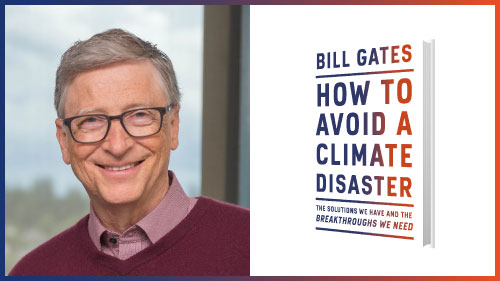Everything you need to know about avoiding the worst climate outcomes.
When I worked at Microsoft, it was always a thrill to see a product we’d been working on for years finally get released to the public. I’m feeling the same sense of anticipation today. My new book on climate change is available now online and in bookstores.
I wrote How to Avoid a Climate Disaster because I think we’re at a crucial moment. I’ve seen exciting progress in the more than 15 years that I’ve been learning about energy and climate change. The cost of renewable energy from the sun and wind has dropped dramatically. There’s more public support for taking big steps to avoid a climate disaster than ever before. And governments and companies around the world are setting ambitious goals for reducing emissions.
What we need now is a plan that turns all this momentum into practical steps to achieve our big goals. That’s what How to Avoid a Climate Disasteris: a plan for eliminating greenhouse gas emissions.
I kept the jargon to a minimum because I wanted the book to be accessible to everyone who cares about this issue. I didn’t assume that readers know anything about energy or climate change, though if you do, I hope it will deepen your understanding of this incredibly complex topic. I also included ways in which everyone can contribute—whether you’re a political leader, an entrepreneur, an inventor, a voter, or an individual who wants to know how you can help.
The effort I founded called Breakthrough Energy, which started with a venture fund to invest in promising clean energy companies, has expanded to a network of philanthropic programs, investment funds, and advocacy efforts to accelerate energy innovation at every step. We’ll be supporting great thinkers and cutting-edge technologies and businesses, as well as pushing for public- and private-sector policies that will speed up the clean energy transition. Over the coming weeks and months, we’ll be turning the ideas in my book into action and trying to turn this plan into reality.
Below is an excerpt from the introduction, which gives you a sense of what the book is about and how I came to write it. I hope you’ll check out the book, but much more important, I hope you’ll do what you can to help us keep the planet livable for generations to come.
This book suggests a way forward, a series of steps we can take to give ourselves the best chance to avoid a climate disaster. It breaks down into five parts:
Why zero? In chapter 1, I’ll explain more about why we need to get to zero, including what we know (and what we don’t) about how rising temperatures will affect people around the world.
The bad news: Getting to zero will be really hard. Because every plan to achieve anything starts with a realistic assessment of the barriers that stand in your way, in chapter 2 we’ll take a moment to consider the challenges we’re up against.
How to have an informed conversation about climate change. In chapter 3, I’ll cut through some of the confusing statistics you might have heard and share the handful of questions I keep in mind in every conversation I have about climate change. They have kept me from going wrong more times than I can count, and I hope they will do the same for you.
The good news: We can do it. In chapters 4 through 9, I’ll break down the areas where today’s technology can help and where we need breakthroughs. This will be the longest part of the book, because there’s so much to cover. We have some solutions we need to deploy in a big way now, and we also need a lotof innovations to be developed and spread around the world in the next few decades.
Steps we can take now. I wrote this book because I see not just the problem of climate change; I also see an opportunity to solve it. That’s not pie-in-the-sky optimism. We already have two of the three things you need to accomplish any major undertaking. First, we have ambition, thanks to the passion of a growing global movement led by young people who are deeply concerned about climate change. Second, we have big goals for solving the problem as more national and local leaders around the world commit to doing their part.
Now we need the third component: a concrete plan to achieve our goals.
Just as our ambitions have been driven by an appreciation for climate science, any practical plan for reducing emissions has to be driven by other disciplines: physics, chemistry, biology, engineering, political science, economics, finance, and more. So in the final chapters of this book, I’ll propose a plan based on guidance I’ve gotten from experts in all these disciplines. In chapters 10 and 11, I’ll focus on policies that governments can adopt; in chapter 12, I’ll suggest steps that each of us can take to help the world get to zero. Whether you’re a government leader, an entrepreneur, or a voter with a busy life and too little free time (or all of the above), there are things you can do to help avoid a climate disaster.
That’s it. Let’s get started.
Republished from Gatesnotes.com










